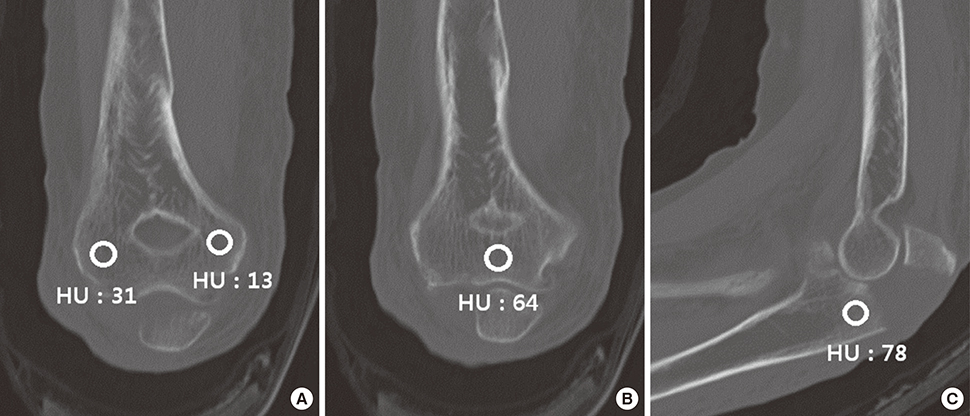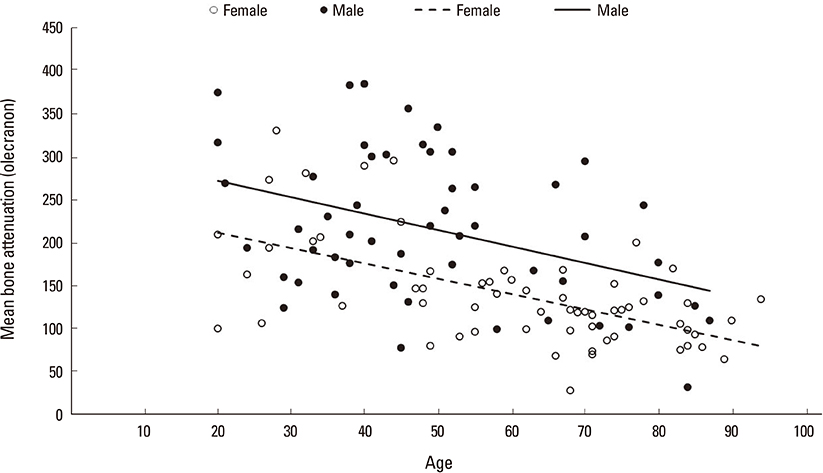J Bone Metab.
2017 Aug;24(3):175-181. 10.11005/jbm.2017.24.3.175.
Olecranon Fractures Have Features of Osteoporotic Fracture
- Affiliations
-
- 1Department of Orthopedic Surgery, Seoul National University College of Medicine, Seoul, Korea. hsgong@snu.ac.kr
- 2Department of Orthopedic Surgery, Seoul National University Bundang Hospital, Seongnam, Korea.
- KMID: 2415955
- DOI: http://doi.org/10.11005/jbm.2017.24.3.175
Abstract
- BACKGROUND
To determine whether olecranon fractures have osteoporotic features such as age-dependent, low bone attenuation and low-energy trauma as a cause of injury.
METHODS
Elbow computed tomography (CT) and medical record review were performed in 114 patients (53 males and 61 females) with acute olecranon fractures. The mean age was 57 years. Bone attenuation was measured on the central part of the olecranon on sagittal CT images avoiding the fracture, and on the distal humerus (distal metaphysis and medial and lateral condyles) on coronal CT images. We compared bone attenuation and causes of injury (high or low energy trauma) between younger (<50 years) and older (≥50 years) patients in each gender. Multiple regression analysis was performed to determine the effect of age and gender on bone attenuation.
RESULTS
Mean bone attenuation in older male and female patients was significantly lower than in younger patients, except at the medial condyle in men. The proportion of low-energy trauma in older male patients was significantly higher than in younger male patients. In female patients, low-energy trauma was predominant in both younger and older patients. Age and female gender had significantly negative effects on bone attenuation.
CONCLUSIONS
This study demonstrated that olecranon fractures have osteoporotic features, including age-dependent low bone attenuation and low-energy trauma as the predominant cause of injury. Our results suggest that osteoporosis evaluation should be considered for patients aged 50 years or more with olecranon fractures.
Keyword
MeSH Terms
Figure
Reference
-
1. Cummings SR, Melton LJ. Epidemiology and outcomes of osteoporotic fractures. Lancet. 2002; 359:1761–1767.
Article2. Caliri A, De Filippis L, Bagnato GL, et al. Osteoporotic fractures: mortality and quality of life. Panminerva Med. 2007; 49:21–27.3. Boonen S, Singer AJ. Osteoporosis management: impact of fracture type on cost and quality of life in patients at risk for fracture I. Curr Med Res Opin. 2008; 24:1781–1788.
Article4. Schuit SC, van der Klift M, Weel AE, et al. Fracture incidence and association with bone mineral density in elderly men and women: the Rotterdam Study. Bone. 2004; 34:195–202.
Article5. Rabar S, Lau R, O’Flynn N, et al. Risk assessment of fragility fractures: summary of NICE guidance. BMJ. 2012; 345:e3698.
Article6. Park C, Ha YC, Jang S, et al. The incidence and residual lifetime risk of osteoporosis-related fractures in Korea. J Bone Miner Metab. 2011; 29:744–751.
Article7. Lee KM, Chung CY, Kwon SS, et al. Ankle fractures have features of an osteoporotic fracture. Osteoporos Int. 2013; 24:2819–2825.
Article8. Barrett-Connor E, Nielson CM, Orwoll E, et al. Epidemiology of rib fractures in older men: Osteoporotic Fractures in Men (MrOS) prospective cohort study. BMJ. 2010; 340:c1069.
Article9. Sajjan SG, Barrett-Connor E, McHorney CA, et al. Rib fracture as a predictor of future fractures in young and older postmenopausal women: National Osteoporosis Risk Assessment (NORA). Osteoporos Int. 2012; 23:821–828.
Article10. Ng AC, Drake MT, Clarke BL, et al. Trends in subtrochanteric, diaphyseal, and distal femur fractures, 1984-2007. Osteoporos Int. 2012; 23:1721–1726.
Article11. Klotzbuecher CM, Ross PD, Landsman PB, et al. Patients with prior fractures have an increased risk of future fractures: a summary of the literature and statistical synthesis. J Bone Miner Res. 2000; 15:721–739.
Article12. Haentjens P, Autier P, Collins J, et al. Colles fracture, spine fracture, and subsequent risk of hip fracture in men and women. A meta-analysis. J Bone Joint Surg Am. 2003; 85-a:1936–1943.13. Tromp AM, Ooms ME, Popp-Snijders C, et al. Predictors of fractures in elderly women. Osteoporos Int. 2000; 11:134–140.
Article14. Kanis JA, Johnell O, De Laet C, et al. A meta-analysis of previous fracture and subsequent fracture risk. Bone. 2004; 35:375–382.
Article15. Earnshaw SA, Cawte SA, Worley A, et al. Colles’ fracture of the wrist as an indicator of underlying osteoporosis in postmenopausal women: a prospective study of bone mineral density and bone turnover rate. Osteoporos Int. 1998; 8:53–60.
Article16. Aitken SA, McQueen MM, Court-Brown CM. The epidemiology of fractures around the elbow joint. El Mednifico J. 2014; 2:189–194.
Article17. Kaas L, Sierevelt IN, Vroemen JP, et al. Osteoporosis and radial head fractures in female patients: a case-control study. J Shoulder Elbow Surg. 2012; 21:1555–1558.
Article18. Palvanen M, Kannus P, Niemi S, et al. Secular trends in the osteoporotic fractures of the distal humerus in elderly women. Eur J Epidemiol. 1998; 14:159–164.19. Kinik H, Atalar H, Mergen E. Management of distal humerus fractures in adults. Arch Orthop Trauma Surg. 1999; 119:467–469.
Article20. Yoo JH, Moon SH, Ha YC, et al. Osteoporotic fracture: 2015 position statement of the Korean society for bone and mineral research. J Bone Metab. 2015; 22:175–181.
Article21. Sanders KM, Pasco JA, Ugoni AM, et al. The exclusion of high trauma fractures may underestimate the prevalence of bone fragility fractures in the community: the Geelong Osteoporosis Study. J Bone Miner Res. 1998; 13:1337–1342.
Article22. Briançon D, de Gaudemar JB, Forestier R. Management of osteoporosis in women with peripheral osteoporotic fractures after 50 years of age: a study of practices. Joint Bone Spine. 2004; 71:128–130.
Article23. Tang BM, Eslick GD, Nowson C, et al. Use of calcium or calcium in combination with vitamin D supplementation to prevent fractures and bone loss in people aged 50 years and older: a meta-analysis. Lancet. 2007; 370:657–666.
Article24. Kanis JA. Diagnosis of osteoporosis and assessment of fracture risk. Lancet. 2002; 359:1929–1936.
Article25. Compston J, Cooper A, Cooper C, et al. Guidelines for the diagnosis and management of osteoporosis in postmenopausal women and men from the age of 50 years in the UK. Maturitas. 2009; 62:105–108.
Article26. Romme EA, Murchison JT, Phang KF, et al. Bone attenuation on routine chest CT correlates with bone mineral density on DXA in patients with COPD. J Bone Miner Res. 2012; 27:2338–2343.
Article27. Schreiber JJ, Anderson PA, Rosas HG, et al. Hounsfield units for assessing bone mineral density and strength: a tool for osteoporosis management. J Bone Joint Surg Am. 2011; 93:1057–1063.
Article28. Batawil N, Sabiq S. Hounsfield unit for the diagnosis of bone mineral density disease: a proof of concept study. Radiography. 2016; 22:e93–e98.29. Johnson CC, Gausden EB, Weiland AJ, et al. Using hounsfield units to assess osteoporotic status on wrist computed tomography scans: comparison with dual energy X-ray absorptiometry. J Hand Surg Am. 2016; 41:767–774.
Article30. Schreiber JJ, Gausden EB, Anderson PA, et al. Opportunistic osteoporosis screening - gleaning additional information from diagnostic wrist CT scans. J Bone Joint Surg Am. 2015; 97:1095–1100.
Article31. Zebaze R, Ghasem-Zadeh A, Mbala A, et al. A new method of segmentation of compact-appearing, transitional and trabecular compartments and quantification of cortical porosity from high resolution peripheral quantitative computed tomographic images. Bone. 2013; 54:8–20.
Article32. Wiegand L, Bernstein J, Ahn J. Fractures in brief: olecranon fractures. Clin Orthop Relat Res. 2012; 470:3637–3641.
Article
- Full Text Links
- Actions
-
Cited
- CITED
-
- Close
- Share
- Similar articles
-
- Clinical Observation of the Olecranon Fracture
- The Clinical Results of Tension Band Wiring
- Stress Fracture of Olecranon after Plate Fixation for Osteoporotic Monteggia Fracture with Absence of Radial Head: A Case Report
- Osteoporotic Hip Fracture: How We Make Better Results?
- Olecranon Fracture Sustained during Arm Wrestling in Middle-Aged Male



